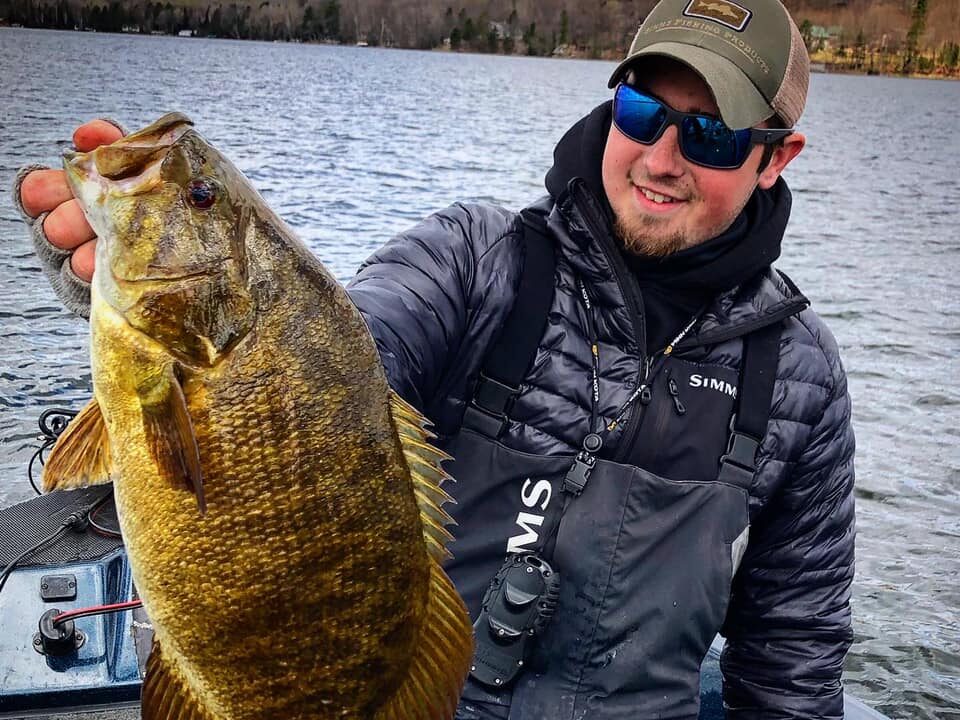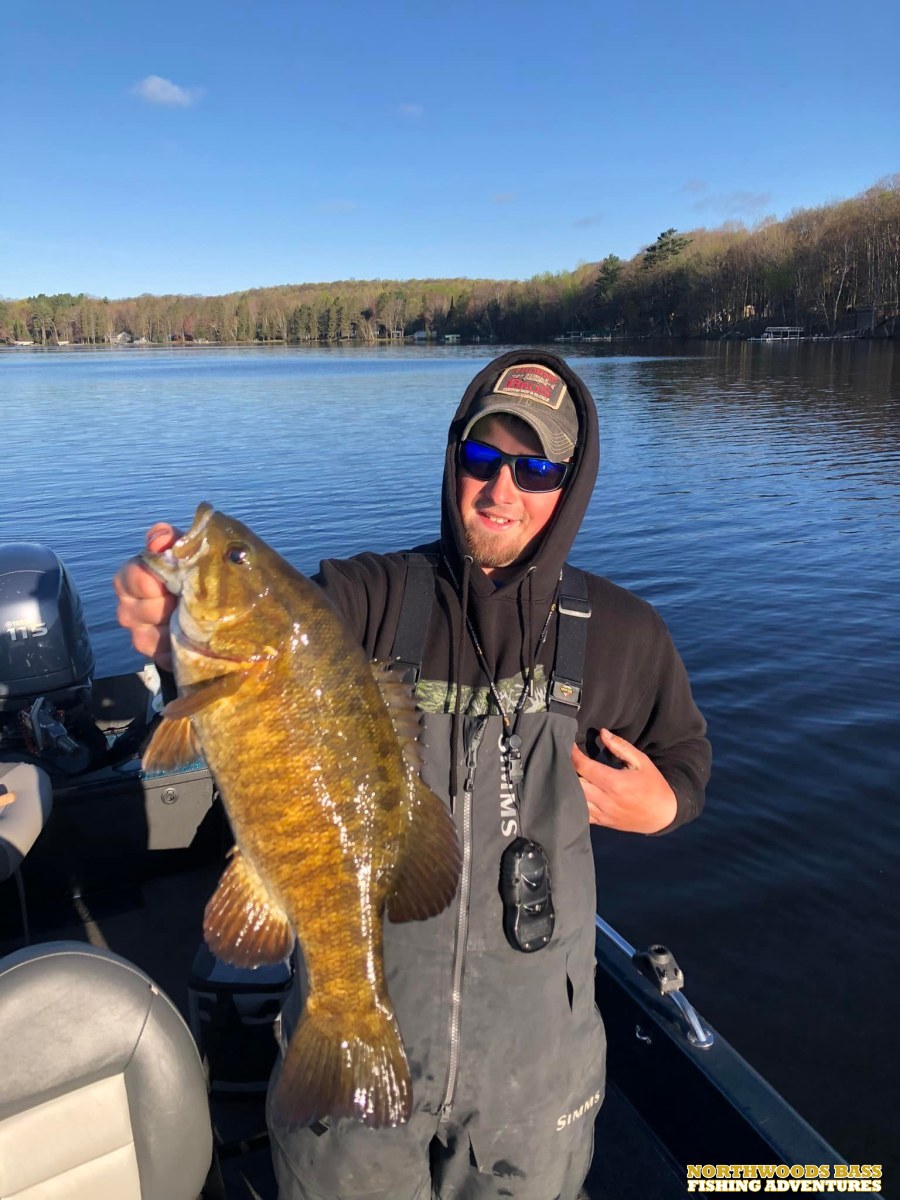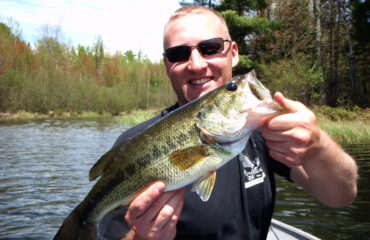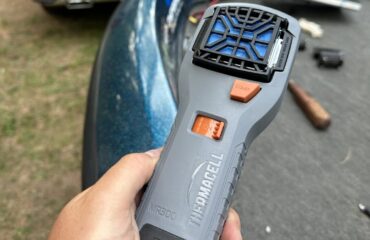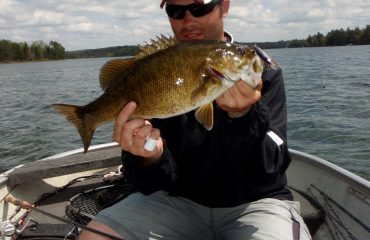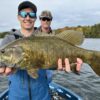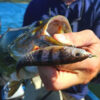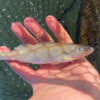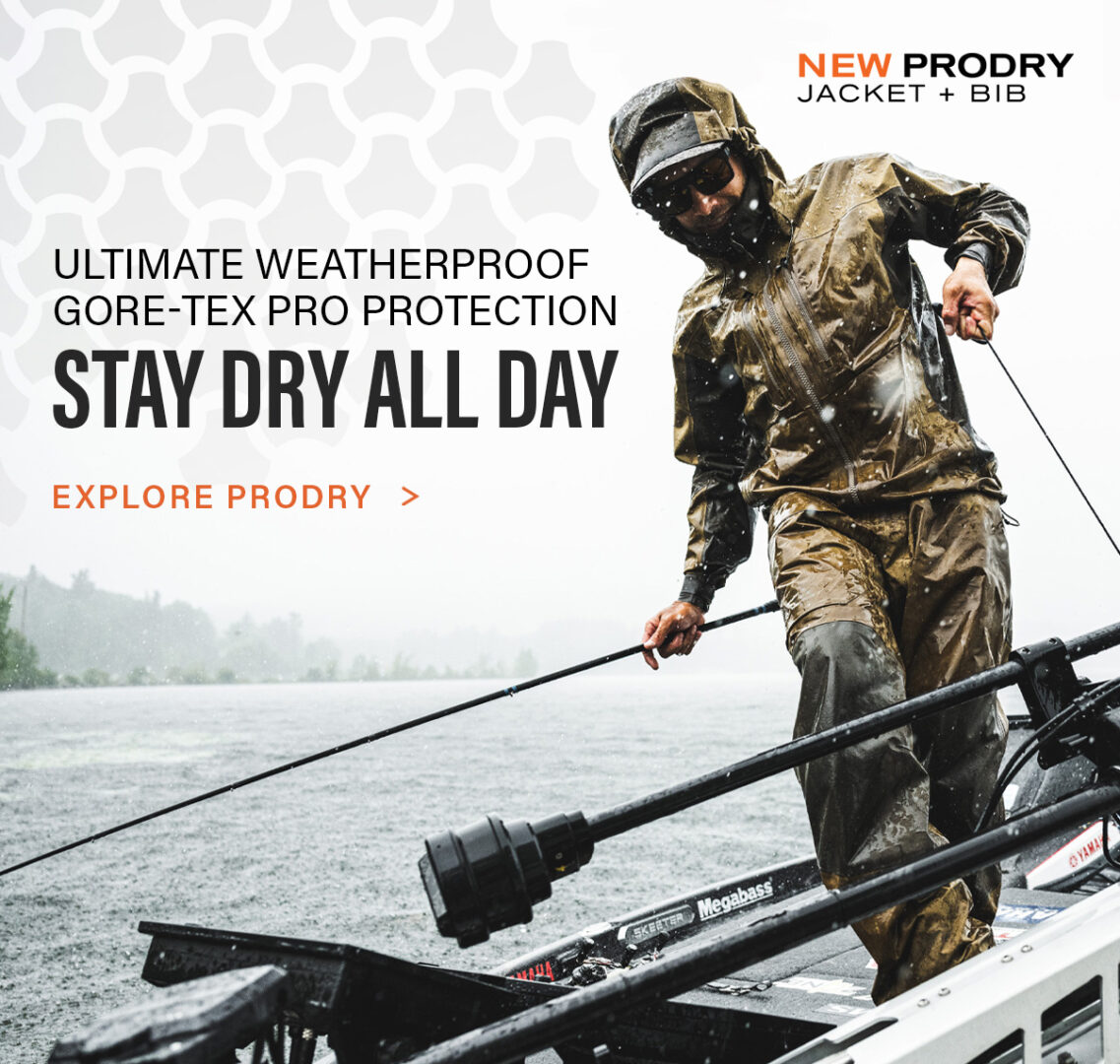Rippin’ Rap Smallmouths
Winter relents. Spring creeps in. Ice has finished melting, and we have open water once again.
At this time, smallmouths are schooling together and stacked; programmed to undergo structural migrations to where they will stage and set-up in preparation for their spawn which could be several weeks away. This process begins well before ice-out, down deep where they winter.
When smallmouths leave their wintering holes and begin staging for the spawn, it’s best to be off the deepest edges of rocky shoals and spawning flats waiting for them to arrive. Depths could vary anywhere from 10 to 25 ft. When and where they will show up in the most heavily concentrated wolf packs is determined by wind and the warm undercurrents it creates, and the angle and placement of the sunlight above.
On the main lake basins, smallmouths will remain in their wintering holes for a week or two following ice-out, or until water temperatures each the mid 40’s. If you’re adept with electronics and have abilities to position atop of them, you can get onto large schools of fish.
Most fishing efforts will be taking place along the deep edges around staging sites, drop-offs, and other deeper contours.
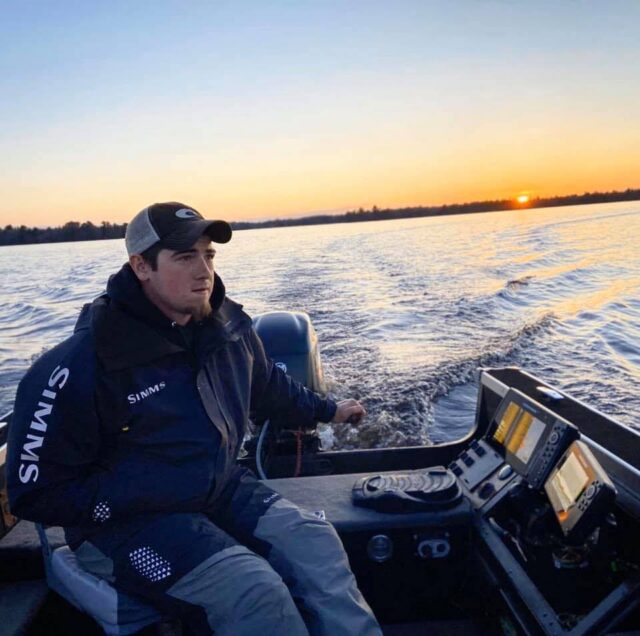
Tom Kolling possesses an extreme passion for fishing as well as sharing it with other anglers. Tom K’s Guide Service specializes in walleyes, smallmouths and muskies in the Eagle River, Wisconsin area, while also offering personalized marine electronics on-the-water classes.
Smallmouth Yo-Yo’s
Typical of the spring coldwater period, most smallmouths are still holding closer near bottom and reaction strikes will provoke them. These fish are most catchable by employing walleye tactics. On Wisconsin’s inland lakes, the most astute walleye anglers have been recently catching monstrous early season smallmouth with rip baits. The #6 and #7 Rapala Rippin Rap is an early season favorite that has achieved a cult following. Some of the biggest smallmouths of the season are caught and released under these circumstances.
“It is my go-to bait at the start of the open water year, and when I don’t know what the fish are really doing yet,” says Eagle River, Wisconsin guide, Tom Kolling.
Kolling focuses on a handful of trophy smallmouth waters, and intently fishes them with Rippin’ Raps. “It’s going to be tied on from ice out until the prespawn bite really picks up. This very cold water period is where I am going to do the most damage with this bait,” he discloses.
This time of season, the deeper locations can be difficult to graph. “This is where the Rippin-Rap really plays a big role in my arsenal,” says Kolling. “I can get on an area where I anticipate the fish to be, and start fan casting my way around the spot, looking for a bite. An active fish is going to take a swipe at this bait, but many times I have had great success using this bait on fish that I couldn’t trigger with anything else!” he exclaims. The bait’s versatility wins him over. “It’s great for covering water as well as getting bites from neutral/negative fish,” he concludes.
Not every lake and its fishery are composed or behave the same. A wide variety of depths will be fished everywhere you go this time of year. “We are actually fishing them in their wintering areas right when the ice goes out,” says Kolling. “These areas are going to be on the deeper side, 20 to 30-feet of water on most lakes I fish. Heavy chunk rock, cribs, or just scattered timber on the bottom will hold smallmouths throughout the winter. This is usually my first spot to look on my first outings of the year.”
Kolling relies heavily on the Mega Down Imaging of his Humminbird Helix-12. “These fish are typically going to be tight to the bottom and can be tough to see on traditional sonar.”
Additionally, Kolling also relies heavily on his Lakemaster navigation charts, especially when exploring new waters. “On new lakes, I rely heavily on Lakemaster lake maps to find areas to check. I look for big, expansive flats typically on the north side of the lake to start my search efforts,” he concludes.
As soon as smallmouths vacate their wintering areas, Kolling relies more on his unit’s mega side imaging. “Once I know the fish have left their wintering areas, the search is on. I will idle outside of spawning shorelines up and down that first break scanning for fish. When I say “first break”, and “just outside”, these terms are relative. There will sometimes be a steeper break nearby, and other times these first breaks will be up to a half mile away from shore. You really are looking for the first structure between the spawning shallows and the deep water. Looking for the depth area that the fish are in is an everyday activity to start out. On warmer days they will move shallower onto nearby flats in 5-15 feet, and on colder cloudy days they will usually be just off the break in 15-20 feet. Knowing the depth they are using each day is key. Early spring weather will move fish around a lot, depth wise, they won’t be far from where they are going to do their business,” he summarizes.
The window may be short. “Usually, it only takes a couple, or sometimes even just one warm sunny day, to start pushing these fish to new and shallower areas to stage to spawn,” admits Kolling. Weather and conditions will dictate where the fish will be.
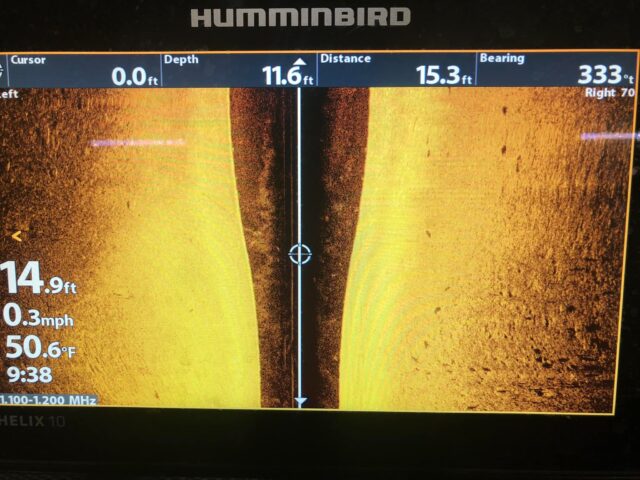
As soon as smallmouths vacate their wintering areas, Kolling relies on Humminbird mega side imaging. He will idle outside of spawning shorelines up and down that first break scanning for fish. Knowing the depth they are using each day is key.
Rip. Rip. Rip. Fish On!
The Rippin’ Rap is his tool for catching these bottom dwellers.
His most-used is the number-6 Rippin’ Rap. “On good fishing days, if you are searching for bigger bites you can go up to the 7. I really haven’t found much success using smaller sizes like a number 5 because it is too light for what I want to accomplish,” he admits.
Kolling fishes a wide variety if waters, and admits that color choice differs for him on all of them. “On clear lakes I am going to reach for natural colors. On cloudy days I like painted or matte finished colors. Some of my favorites are Pearl Gray Shiner, Perch, Crawdad, and Red Crawdad. On sunny days I am always reaching for chrome finished baits. My favorites are Road Trip, Fruit Bowl, Chrome, and Gold Chrome.” Meanwhile on stained waters or on cloudy days, he favors darker patterns that have dark purple or brown. These past two springs, Kolling hammered them on flowages with a matte black spray-painted #6.
Kolling revealed his all time favorite is “bad lipstick”, a chrome finished purple/gold.
The Rippin-Rap has such a unique shape and action compared to other lipless baits, and is irresistible to smallmouths when worked with a yo-yo style retrieve. This erratic, subtle ripping motion, can generate wicked reaction strikes out of the most lethargic fish.
“Cadence is by far the biggest player when working Rippin’ Raps,” says Kolling. “It changes every day, and will sometimes change throughout the day,” he admits. Kolling has adopted his Rippin’ Rap techniques from the walleye fishing which he specializes the most in.
The most common tactic is yo-yo-ing the bait. “Cast it out, and allow it to sink to the bottom. Rip it up, and let it fall. This is how I am using this bait 99% of the time,” he instructs.
It seems simple from afar, but Kolling admits that he’s changed the outcome of several fishing trips by dialing in and adjusting his cadence. “Fall rate is huge, and probably the biggest factor. How tight you keep your line on the fall will dictate how fast the bait is falling as well as the action it has on the way down. A slack line fall is the best way to trigger a reaction bite. Lifting the bait up and letting it crash to the bottom produces the most bites on a tough day. Smallmouths will usually pin the bait to the bottom like walleyes, sometimes not even fully eating the bait. You usually won’t even feel the bite, and as you go to rip the bait up a fish will be on the other end.”
When smallmouths are more active, Kolling’s up-rip will be longer. “One to three foot up-rips work well on these days. When I am doing this I am actually holding my rod up and keeping the line tight on the fall. This makes the bait hang and wobble on the way down. These bites can be ferocious! As the bait is falling you will feel the fish whack the bait.”
Cadence and retrieves differ daily, but the above serves as Kolling’s guideline. Furthermore, the many combinations and additional possibilities are endless.
“You really just have to try all kinds of different lift and fall rates between those guidelines. Play with it, change it up often if you are not getting bit in a fishy area, and pay attention to what you did when you got a bite.”
Rippin’ Raps perform at their fullest potential being fished on the bottom.
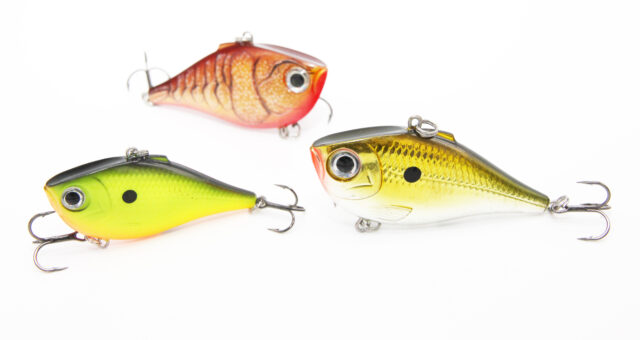
Long Rods and Fast Reels
Kolling warns that rod and reel choice can be the difference between catching many and catching nothing. He advises you’ll need a stiffer rod action to work it properly.
“I prefer a 7 to 7 foot 6-inch medium, or MHF spinning rod. This length and action gives the bait a nice sharp, crisp up-rip. You don’t want the rod to be halfway loaded up on your rip,” he advises. An improper rod action will deter lure action, and make hook sets challenging when smallmouths are plucking them off the bottom.
Oftentimes, hook sets occur during the up-rip. Kolling accompanies his rod with a size 30 or 40 spinning reel with a quick line pick-up and gear ratio. Set the drag somewhere to the middle, which will avoid blown hook-sets as well as possibly tearing the bait away from ‘ole small jaws.
“I’m fishing it on a 10 lb. braided main line with 5 to 10 feet of 12 lb. fluorocarbon in clear lakes, and 15 lb. leader on darker water. I am always connecting my lead to the main line with an Albright knot. I would also suggest running a small snap to connect the bait to your line. This will give the bait a better range of motion.”
One last modification Kolling does is replacing the rear treble hook. “The #6 comes with a #6 treble on the front and #8 on the back. I will upsize the back hook to match the front. You can also swap the front and back hook around. I always want the larger hook on the back of the bait for short strikes.”
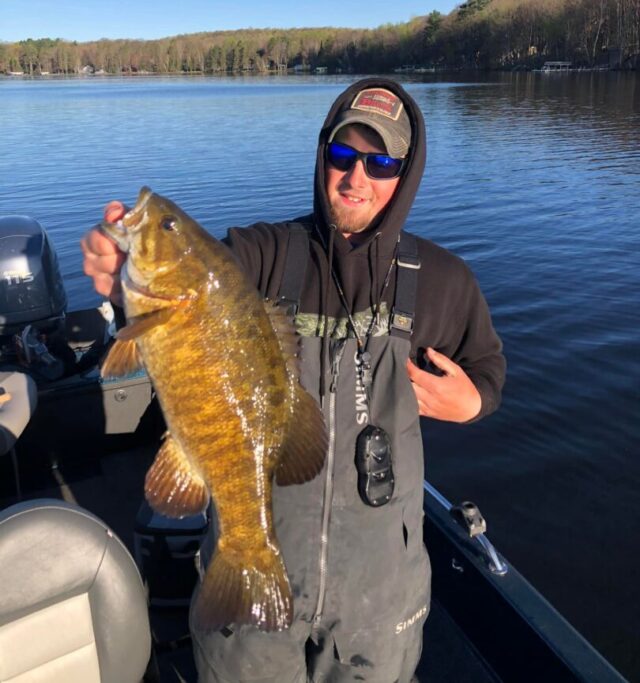
Time of day and ideal conditions make a difference in the success of the strategy, and he never wants to arrive at a boat landing until midday. Kolling prioritizes late afternoons and evenings. Sunlight is everything.
Angry Strikes
Time of day and ideal conditions make a difference in the success of the strategy. Weather and temperature trumps everything in spring.
“Typically the early afternoon to evening is almost always the best time to be on the water in the early spring. The sun gets high and heats things up, and the fish follow.”
Rarely in the spring does Kolling ever want to be at the boat ramp at sun-up. “As much as I want to be, most days your bite won’t pick up until 10:30am to noon. You can absolutely have some wicked bite windows towards sunset, however. The water has been heating up all day, maybe the fish will push shallower or just turn on where they have been all day, and some days I can put 20-30 fish in the boat the last hour of the day,” he reveals.
Bass anglers throughout the country are beginning to utilize the Rippin’ Rap more. It’s tiring, and can be exhausting with the improper rod and reel, but worthwhile. The key with this aggressive fishing style is prompting reaction strikes, engaging them, and tempting their curiosity. Never allow smallmouths to get a good look of the lure.
“Over the last couple of years, it has proven to be one of my best early spring baits, if not the best early spring bait,” Kolling admits. “Quite honestly, I use them much more targeting bass than walleye. Smallmouths and walleye act very similarly during their pre-spawn periods, and I think that is why many anglers experience success early in the year for both species. In many cases walleyes and bass are in the same areas during the early spring, therefore you will absolutely run into both at times,” he concludes.
Pursuing early season smallmouths with Rippin’ Raps has led to some of our largest specimens and captures of the year in recent seasons. The tactic is also deadly in late fall too.
Fish Midday
Tom Kolling possesses an extreme passion for fishing as well as sharing it with other anglers. Tom K’s Guide Service specializes in walleyes, smallmouths and muskies in the Eagle River, Wisconsin area, while also offering personalized marine electronics on-the-water classes. Visit him online at www.tomksguideservice.com or call (715) 891-9078
Andrew Ragas splits time between the Chicago area and Wisconsin’s Northwoods. Based in Minocqua, WI, he specializes in trophy bass fishing and offers guided trips from May thru October. While big bass is the passion, he dabbles in multi-species as well. He may be visited online at www.northwoodsbass.com


